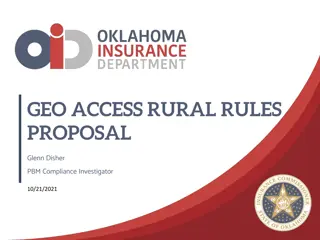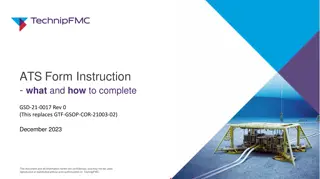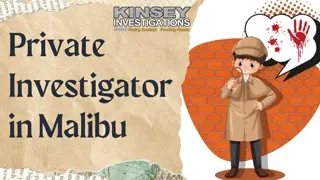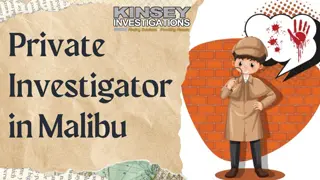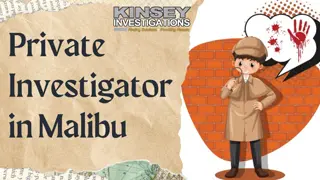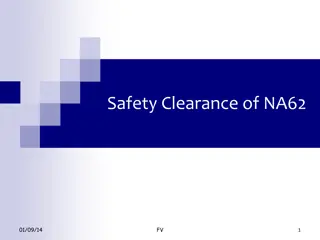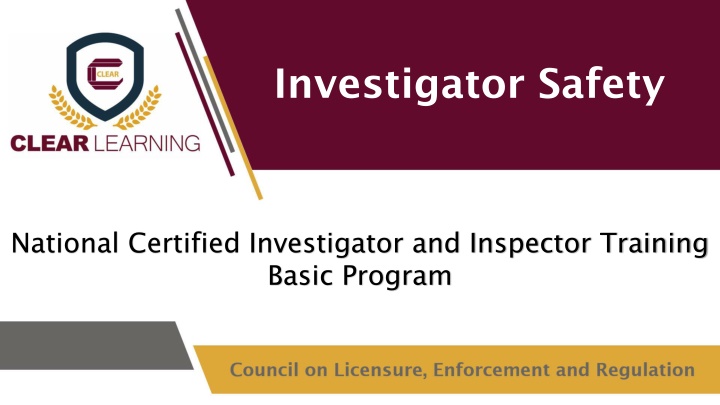
Certified Investigator Safety Training Program
Enhance your knowledge on security and safety concerns with the Investigator Safety National Certified Investigator and Inspector Training Basic Program. Learn de-escalation techniques and how to recognize threatening situations to ensure your safety in the field.
Download Presentation

Please find below an Image/Link to download the presentation.
The content on the website is provided AS IS for your information and personal use only. It may not be sold, licensed, or shared on other websites without obtaining consent from the author. If you encounter any issues during the download, it is possible that the publisher has removed the file from their server.
You are allowed to download the files provided on this website for personal or commercial use, subject to the condition that they are used lawfully. All files are the property of their respective owners.
The content on the website is provided AS IS for your information and personal use only. It may not be sold, licensed, or shared on other websites without obtaining consent from the author.
E N D
Presentation Transcript
Investigator Safety National Certified Investigator and Inspector Training Basic Program
Session Introduction
Upon completion of the session, you will be able to: Learning Objectives Describe security and safety concerns faced by investigative staff and ways they may be reduced. Identify appropriate de-escalation techniques and when they should be used.
Session Map Investigator Safety Safety Survey Confrontational or Threatening Situations De-Escalation Techniques
Investigator Safety Survey Have you ever walked into an interview or inspection and noticed a weapon on the premises? A. Yes B. No
Investigator Safety Survey Are you permitted to bring law enforcement support along on investigations, interviews, and/or inspections? A. Yes B. No C. Unsure
Investigator Safety Survey Have you ever gone to a subject s home or location selected by a subject for an interview and not told anyone where you were going? A. Yes B. No
Investigator Safety Survey Have you ever had an internal bad feeling about an investigation, inspection, or interview and done it anyway? A. Yes B. No
Confrontational or Threatening Situations
Confrontational or Threatening Situations Use cues from physical behavior to determine mood Facial expressions Eye contact Tone of voice Maintain constant awareness of surroundings Investigator Triad
Awareness of Self Recognize perceptions of you as an investigator and your authority over licensees Takes constant effort to mitigate these perceptions Managed through HR and Situational Management skills Remember who you are
Awareness of Others Observe and interpret emotional and physical behavior Behavioral Based Analysis Remember who they are
Awareness of Environment Maintain constant awareness of environment People Objects Physical location Static vs Dynamic environments Know egress paths and locations Remember where you are
What just happened? What did the person say? Did they make any gestures? What were they wearing? What else did you notice? Exercise: Situational Awareness
Fight or Flight Instinct Natural instinct possessed by all beings This reliable instinct provides danger radar and should not be ignored Must know how to read and react to potentially dangerous encounters
De-Escalation Techniques
De-escalation Techniques Dealing with Human Beings We never know how people will respond in a given situation Behavior is controlled by logic and reason to a point Being the subject of an investigation may send some people into survival mode
Using Verbal De-Escalation Use only in potentially violent situations when no weapon is involved Reasoning with an enraged person is not possible De-Escalation techniques are counter-intuitive and must be practiced before they are needed
Be in Control of Yourself Appear Calm Use low tone of voice Remove jewelry or scarves Remove religious or political symbols Do not be defensive Be aware of options for back-up Be respectful while firmly setting limits Treat the subject with respect
Physical Stance Never turn your back Stay on the same eye level Allow extra space between yourself and the subject Do not maintain constant eye contact
Physical Stance Do not point or make aggressive gestures Do not touch the person- for any reason Keep hands out of pockets
The De-Escalation Discussion Only goals is to reduce the level of emotion Do not raise your voice Respectfully answer informational questions, even if rudely asked Do not answer abusive questions Explain limits and give choices where possible Do not solicit or analyze feelings
The De-Escalation Discussion Do not argue or try to convince Encourage the subject to think cognitively Suggest alternative behaviors, where appropriate Give consequences of inappropriate behavior without threats Represent controls as institutional Trust your instincts
Knowledge Check De-escalation techniques: A. Are counterintuitive since they require us to do things we would not usually do. B. Work only when the subject can see the investigator. C. May be used only by trained psychologists. D. Are always effective in situations where weapons are involved.
Knowledge Check When using de-escalation techniques the investigator should: A. Maintain constant and persistent eye contact with the subject. B. Adopt a submissive gesture toward the subject and keep hands in pockets. C. Use a modulated, low tone of voice with the subject. D. Place a hand on the subject s shoulder and speak loudly and firmly
You should now be able to: Learning Objectives Review Describe security and safety concerns faced by investigative staff and ways they may be reduced Identify appropriate de-escalation techniques and when they should be used.
Session Evaluation
A. Unacceptable B. Needs to Improve C. Is Good D. Is Very Good E. Excellent In general, this instructor:
A. Unacceptable B. Needs to Improve C. Is Good D. Is Very Good E. Excellent The style of delivery:
A. Unacceptable B. Needs to Improve C. Is Good D. Is Very Good E. Excellent The content:
A. Unacceptable B. Needs to Improve C. Is Good D. Is Very Good E. Excellent The amount of material covered:
A. Unacceptable B. Needs to Improve C. Is Good D. Is Very Good E. Excellent The usefulness of this session:







